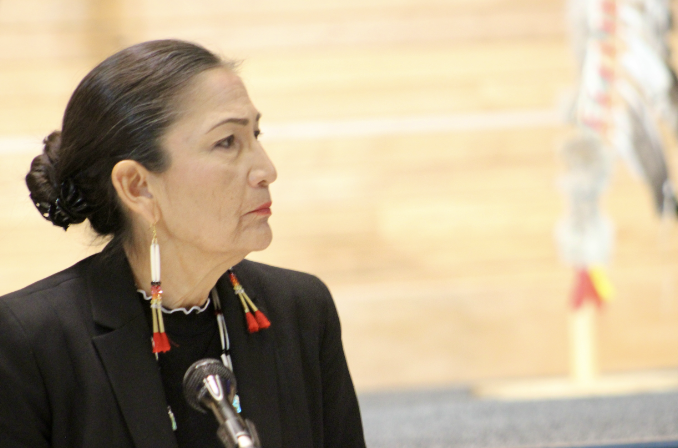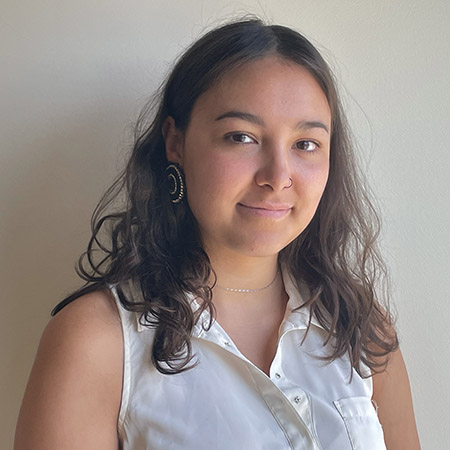
- Details
- By Neely Bardwell
Native Vote 2024. Within 36 hours of stepping up after President Joe Biden dropped out of the presidential race last Sunday, Vice President Kamala Harris has become the presumptive Democratic Party nominee. Harris is now tasked with choosing a running mate who can serve as vice president. Some Natives think Interior Secretary Deb Haaland (Laguna Pueblo) should be added to the list.
U.S. presidential candidates are often judged by who they select as their running mates because it allows the American voter a glimpse into their decision-making process, even before they are elected. Fortunately for Vice President Harris, the prospects are plentiful because the Democrats seem to have a nice bench of future presidential hopefuls.
Currently, the list of potential running mates include: Pennsylvania Gov. Josh Shapiro, North Carolina Gov. Roy Cooper, Sen. Mark Kelly (D-AZ), Kentucky Gov. Andy Beshear, Illinois Gov. J.B. Pritzker, Michigan Gov. Gretchen Whitmer, California Gov. Gavin Newsom, Minnesota Gov. Tim Walz, and U.S. Transportation Secretary Pete Buttigieg.
Buttigieg is the only current presidential cabinet member named by the media.
In 2020, Biden nominated Haaland to be secretary of the U.S. Department of the Interior. When she was confirmed by the U.S. Senate, she became the first Native American to serve in a presidential cabinet to fill a secretarial role. When Biden announced her name, Indian Country praised the nomination.
Since taking the role, Haaland has been running a federal department that employs some 70,000 people, including expert scientists and resource-management professionals, in eleven technical bureaus which includes the Bureau of Indian Affairs. The Interior’s current budget for fiscal year 2024 was $89.08 billion. The Fiscal Year 2025 President's Budget request for Indian Affairs programs is $4.6 billion.
Haaland established the Missing & Murdered Unit with the Bureau of Indian Affairs to address the epidemic of missing and murdered Natives. Additionally, she established the Federal Indian Boarding School Initiative to investigate the history of American Indian boarding schools, as well as taking the “Road to Healing” Tour across tribal nations hearing from survivors and descendants of boarding schools.
In 2023, Secretary Haaland oversaw the largest-ever increase of public land co-stewardship agreements with Tribes across the country, growing from 20 to 200. On top of that, the Department protected more than 12.5 million acres of public lands as national monuments, mineral withdrawals, wildlife refuges, and more. Combined, all these areas would be about the size of Virginia.
The above actions are only a fraction of what Haaland has accomplished during her time as Secretary of the Interior. Now, Indian Country is excited to see what could be next for Haaland.
On Tuesday, while attending the 2024 Native Power Building Summit in Scottsdale, Ariz., Minnesota Lt. Gov. Peggy Flanagan (White Earth Ojibwe) told Native News Online that Haaland has served the country well in her role as secretary of the Interior.
“I feel like Deb Haaland’s future is very bright no matter what she is called to do,” Flanagan said. “Being the vice president would be a dream come true.”
Holly Macaro (Red Lake Ojibwe), a principal at The Angle, a political and government affairs consulting firm, commented on Tuesday on the possibility of Haaland being added to the short list of possible candidates for vice president.
“The vice president contest will be the hottest topic for the next few days – and there are multiple ways it could impact Indian Country: the addition of Deb Haaland to the short list would be historic and not beyond the imagination,” Macarro said. “She is a proven leader, a valuable asset in the Biden Administration’s climate agenda, and the powerful voice behind the historic investments in Indian Country.
In another potentially historic move, if Gov. Walz is chosen as vice president and elected in November, it would elevate Lt. Gov. Flanagan to governor of Minnesota; She’d be the first ever Native American to govern a state.
A major consideration for Vice President Harris’ selection of a running mate is what candidate, who aligns with her ideologies for governing, would garner the most electoral college votes. She will consider who, on the short list candidates, can help deliver a win in swing states.
The case for Haaland is her potential to win over key battleground states, the majority of which fall within Indian Country. In battleground states–or swing states–like Arizona, Michigan, Nevada, North Carolina, and Wisconsin, the Native vote could influence the direction of the election. That is only if Natives turn out to the polls.
There are predicted to be at least 5 million Native and Alaska Native-identifying voters in the U.S., according to the U.S. Census Bureau — although these estimates are expected to be an undercount.
“Native Americans are incredibly influential and have the ability to really swing those elections on the margins," said Jacqueline De León, a senior staff attorney at the Native American Rights Fund originally to OPB, adding that she sees the potential for Native voters to decide elections where the population of Native Americans is bigger than the vote differentials that decide those races.
Levi Rickert contributed to this article from Scottsdale, Ariz.
If Haaland is selected and elected as Harris’ running mate, she wouldn’t be the first Native American to serve as vice president of the United States. Vice President Charles Curtis, a descendent of Kaw Chief White Plume and Osage Chief Pawhuska, was President Herbert Hoover’s running mate in 1929. Curtis served in the U.S. Senate from 1906 until 1929. From 1924 until he became vice president in 1929, he was the Senate Majority Leader.
More Stories Like This
Native News Weekly (August 25, 2024): D.C. BriefsUS Presidents in Their Own Words Concerning American Indians
Breaking: Ben Nighthorse Campbell, Cheyenne Leader and Former U.S. Senator, Walks On
Zuni Youth Enrichment Project Joins 10th National Farm to Cafeteria Conference, Strengthens Partnerships for 2026 Food Sovereignty Work
Top Five Most-Read Stories in 2025 on Native News Online
Help us defend tribal sovereignty.
At Native News Online, our mission is rooted in telling the stories that strengthen sovereignty and uplift Indigenous voices — not just at year’s end, but every single day.
Because of your generosity last year, we were able to keep our reporters on the ground in tribal communities, at national gatherings and in the halls of Congress — covering the issues that matter most to Indian Country: sovereignty, culture, education, health and economic opportunity.
That support sustained us through a tough year in 2025. Now, as we look to the year ahead, we need your help right now to ensure warrior journalism remains strong — reporting that defends tribal sovereignty, amplifies Native truth, and holds power accountable.
 The stakes couldn't be higher. Your support keeps Native voices heard, Native stories told and Native sovereignty defended.
The stakes couldn't be higher. Your support keeps Native voices heard, Native stories told and Native sovereignty defended.
Stand with Warrior Journalism today.
Levi Rickert (Potawatomi), Editor & Publisher

